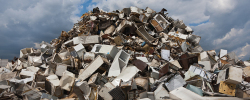

The Building Research Establishment (BRE) has issued new guidance on dealing with demolition waste which is difficult to recover due to its material composition, contamination or low value, or due to the techniques typically used during demolition.
Typically, over 90% of demolition waste is diverted from landfill. However, as a result of the changing composition of demolition waste, there is a growing concern in the sector and beyond that it may not be possible to improve or maintain these high recycling rates in the future, resulting in increased demolition waste being sent to landfill.
‘Difficult’ waste has hazardous qualities, high-embodied energy or global warming potential, and so an inability to recover these waste products at the end of their life increases their overall impact on the environment.
The new BRE guide, Dealing with Difficult Demolition Wastes, is published by IHS BRE Press and gives practical guidance on waste management routes and how to improve reuse, recycling and recovery of 'difficult' demolition waste, such as carpet underlay, insulated concrete formwork, industrial batteries, structural insulated panels (SIPs) and smoke alarms.
Funded by BRE Trust, this guidance will be useful to the demolition sector, designers in the respective product supply chains who are concerned with increasing reuse and recycling at end of life, waste and recycling policymakers and their advisors, and construction clients and contractors who have targets to divert increasing amounts of waste from landfill.
The guide is available from www.brebookshop.com or from IHS by calling +44 (0) 1344 328038, ref. FB 54.
If you'd like to keep up-to-date with the latest developments in the heating and plumbing industry, why not subscribe to our weekly newsletters? Just click the button below and you can ensure all the latest industry news and new product information lands in your inbox every week.